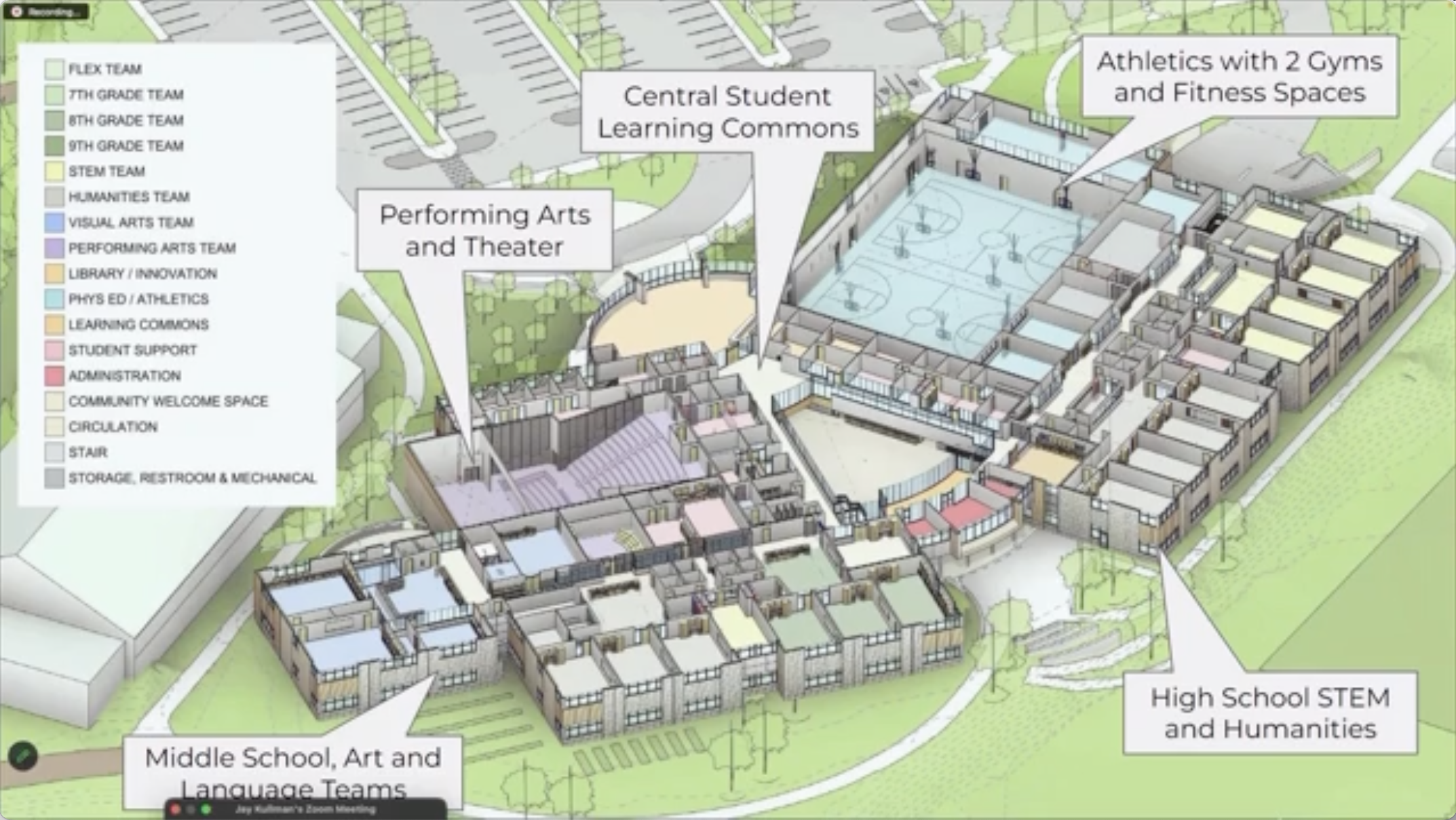PLYMOUTH, Vt. – The majority of the Jan. 16 Plymouth Selectboard meeting was a presentation from Mountain Views Supervisory Union (MVSU) Board Chair Keri Bristow, Vice Chair Ben Ford, and Plymouth representatives Elliot Rubin and Josh Linton, on the proposed Woodstock Middle/High School reconstruction, and how that will impact Plymouth taxpayers.

Plymouth is one of seven towns in the Woodstock school district, and was the first town to see the presentation. The extensive project, which includes rebuilding an entirely new school, demolishing the old building, and constructing a new football field on the existing building property, has a price tag of $99 million.
The current building was built in 1958, is in major disrepair, and rated the second worst high school facility in the State of Vermont. Ford explained that the building cannot be remodeled due to the dated materials and concrete cinder block structure. They have a broken HVAC system that leaves students and staff either “boiling” hot or extremely cold, and below standard and acceptable temperatures. The sewage has been known to back up in the bathrooms. They are down to one shower in the locker room because the mixing valve cannot be repaired from behind the cinderblock walls. There are “horror stories” of all the things that need to be addressed. Bristow added, though it is not a pleasant environment, the air and water quality are being monitored to ensure everyone’s safety.
About 70% of the revenue that funds the school comes from education property tax, the remaining funds from sales and use taxes, school choice students, and other sources. Ford assured that the MVSU is trying to keep taxpayers in mind and “cap the impact of taxes that a project like this can have… [and] set a limit so voters can have some confidence,” and not be hit too hard. The board scaled back on some of the designs and ideas, which reduced the budget by $16 million, to bring the project down to the current estimated $99 million.
Ford also explained that the board is hoping a state school construction program will be offered again in the near future, which would help reimburse some of the construction costs. The proposed design for the Woodstock school comes in at $627 per square foot, which is within the new state standards to be eligible if the program returns. Ford noted that is also lower than statewide school construction project averages, which ranged from $633 to over $700 per square foot.
Ford expressed that they took a lot of consideration into each space, trying to get 80-90% usage in each room all day, otherwise questioning if they need that room or not. The cafeteria, for example, is currently only used two to three hours a day, but could be used throughout day for events and projects under the proposed new design. The auditorium can also be used for lectures and other events. There is a double gym design for the benefit of the middle and high school students. There are “no spaces in this design plan that would be empty for long periods,” which saved a lot of space in the overall design. “We thought really long and hard about every square foot.”
The bond repayment for the project would not start until summer of 2027, which gives taxpayers three and a half years before it will impact education property taxes. They provided an example that a home with a fair market value of $300,000, and a household income of $85,000, would see an increase of about $60 per month in taxes.
Each student enrolled in the district reduces the annual amount needed to be raised from taxpayers by about $20,000. If the school district gains 10 or more students per year, “the taxes would be inverted, and benefit back to the taxpayers” after year 15 of the bond payments, “and that’s the goal,” Ford said.
Bristow said that there are many Ludlow students who seriously consider Woodstock because they’re not happy with the options they have, and it is a similar distance to Green Mountain. The board is looking at opportunities and strategies to visit selectboards and school boards, and encourage students to come visit and apply for school choice.
Alternatively, if they do not get the bond and reconstruct the school, the expenses each year to keep it together would rise, and tax rates would increase exponentially every year.
If the bond vote passes, they would take a couple of months to finalize the details of the construction. There would be an 18 month timeline to construct the new building, move students over to the new building for the start of the 2026 school year, demolish the current building, and construct a new football field on the existing property. The supervisory union is urging everyone to vote on Town Meeting day, March 5.
The selectboard then tabled a discussion on a proposal of $15,325 to add three heat pumps to the annex building, since it is currently only being used for town record storage and does not have any use in the main area. They discussed reappraisals being slated for 2026, and then compared companies that assist with land records, and the importance of keeping those documents on site.
The next selectboard meeting will be held Monday, Feb. 5, at 6 p.m.